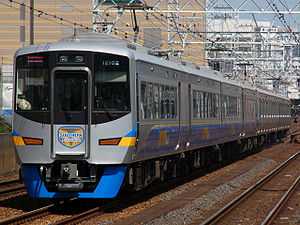Nankai 50000 series
| Nankai 50000 series | |
|---|---|
 | |
| In service | 1994 Present |
| Manufacturer | Tokyu Car Corporation |
| Family name | Rapi:t |
| Constructed | 1994 |
| Entered service | 1994 |
| Number built | 36 |
| Number in service | 36 (6 sets) |
| Formation | 6 cars per trainset |
| Capacity | 252 |
| Operator | Nankai Electric Railway |
| Depot(s) | Suminoe, Chiyoda |
| Line(s) served | Nankai Main Line, Airport Line |
| Specifications | |
| Car body construction | Steel |
| Train length | 125.6 m (412 ft 1 in) |
| Width | 2,850 mm (9 ft 4 in) |
| Height | 4,140 mm (13 ft 7 in) |
| Doors | Plug doors: 1 per car |
| Maximum speed |
110 km/h (70 mph) (Nankai Line) 120 km/h (75 mph) (Airport Line) |
| Weight | 219 t (216 long tons; 241 short tons) |
| Traction system | Variable-frequency |
| Acceleration | 2.5 km/(h·s) (1.6 mph/s) |
| Deceleration |
3.7 km/(h·s) (2.3 mph/s) (service) 4.0 km/(h·s) (2.5 mph/s) (emergency) |
| Electric system(s) | 1,500 V DC, Overhead line |
| Current collection method | Pantograph |
| Bogies | Bolsterless SS-137/SS-037 |
| Braking system(s) | Regenerative brake, electronically controlled pneumatic brakes |
| Safety system(s) | ATS |
| Track gauge | 1,067 mm (3 ft 6 in) |
The Nankai 50000 series (南海50000系) is a limited express electric multiple unit (EMU) train type operated in Japan by the private railway operator Nankai Electric Railway. These 6-car trains were introduced in 1994 on the new Rapi:t limited express service on the Nankai Airport Line serving Kansai International Airport, which opened on 4 September 1994.
Operations
It is used on the Airport Line Rapi:t limited express services. The trains run between Namba and Chiyoda Depot, and have also been used occasionally on special-event services to Wakayamashi and Misakikoen.
Design
The external styling of the train was the work of Hiroyuki Wakabayashi, an architect who was also responsible for designing Uji Station on the Keihan Uji Line. The design theme was "Outdated Future", and is the reason for the train's futuristic and retro styling. The end cars feature streamlined cabs with no gangway connections. The cars are painted an all-over metallic deep blue colour. The side windows are elliptical in shape, giving an aircraft-like appearance.
Formation
As of 1 April 2013, the fleet consists of six 6-car sets with three motored ("M") cars and three non-powered trailer ("T") cars formed as shown below, with car 1 at the Wakayama end.[1]
| Car No. | 1 | 2 | 3 | 4 | 5 | 6 |
|---|---|---|---|---|---|---|
| Designation | Tc2 | M3 | T1 | M2 | M1 | Tc1 |
| Numbering | 50700 | 50200 | 50600 | 50100 | 50000 | 50500 |
- Cars 2 and 5 are each fitted with two cross-arm type pantographs.[1]
- Cars 5 and 6 have "Super Seat" accommodation.[1]
- Cars 3 and 5 have toilets.[1]
Interior
All seats in standard and super-seat cars (Nos 5 and 6) are reserved and no smoking. Cars 3 and 5 feature a service counter and vending machines.
Livery variations
Mobile Suit Gundam UC × Limited Express Rapi:t Neo Xeon Version
One trainset was repainted in an all-over red livery in a tie-up coinciding with the release of Episode 7 of the Mobile Suit Gundam Unicorn series and to mark the 20th anniversary of the opening of the Nankai Airport Line. The repainted set returned to service on 26 April 2014 and ran until 30 June.[2]
-

The red-liveried Gundam set, May 2014
-

Interior of the Gundam set, May 2014
Peach × Rapi:t Happy Liner
From 7 September 2014, one 50000 series set was reliveried in a special "Peach × Rapi:t Happy Liner" livery as part of a promotional tie-up with the low-cost airline Peach Aviation.[3] The reliveried trainset is scheduled to operate until 31 August 2015.[3]
-
.jpg)
The Peach × Rapi:t Happy Liner set, September 2014
References
- ↑ 1.0 1.1 1.2 1.3 私鉄車両編成表 2013 [Private Railway Rolling Stock Formations - 2013]. Japan: JRR. 30 July 2013. p. 152. ISBN 978-4-330-39313-1.
- ↑ "Mobile Suit Gundam × Limited Express Rapi:t "Second Coming of Red Comet Limited Express Rapi:t Neo Zeon Version"". News release. Nankai Electric Railway Co., Ltd. 10 April 2014. Retrieved 10 April 2014.
- ↑ 3.0 3.1 "「Peach×ラピート ハッピーライナー」運転開始" ["Peach × Rapi:t Happy Liner" enters service]. Japan Railfan Magazine Online (in Japanese). Japan: Koyusha Co., Ltd. 8 September 2014. Retrieved 8 September 2014.
External links
| Wikimedia Commons has media related to Nankai 50000 series. |
| ||||||||||||||||||||||||
